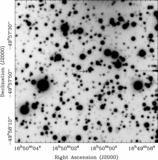Orbital Parameters for the Black Hole Binary XTE J1650-500
Abstract
We present R-band photometry of the X-ray transient and candidate black hole binary XTE J1650-500 obtained between 2003 May and August with the 6.5 m Clay telescope. A timing analysis of these data reveals a photometric period of 0.3205+/-0.0007 days (i.e., 7.63 hr) with a possible alias at 0.3785 days (9.12 hr). Our photometry completely rules out the previously published spectroscopic period of 0.212 days (5.09 hr). Consequently, we reanalyzed the 15 archival ESO VLT spectra (obtained 2002 June by Sanchez-Fernandez et al.) that were the basis of the previously published spectroscopic period. We used a ``rest-frame search'' technique that is well suited for cases in which the signal-to-noise ratio of individual spectra is low. For each of roughly 1.1 million binary ephemerides, we summed all of the spectra in a trial rest frame of the secondary star, and each rest-frame spectrum was cross-correlated against a template spectrum. We then searched for the set of orbital parameters that produced the strongest cross-correlation value. The results confirmed the photometric period of 0.3205 days and ruled out the alias period near 0.38 days. The best value for the velocity semiamplitude of the companion star is K2=435+/-30 km s-1, and the corresponding optical mass function is f(M)=2.73+/-0.56 Msolar. The spectral type of the companion star is not well constrained because we only have six template spectra available to us. The K4 V template provides the best match; next-best matches are provided by the G5 V and K2 III templates. We also find that the accretion disk dominates the light in the R band where the disk fraction is 80% or higher, although this value should be treated with caution owing to the poor signal-to-noise ratio and the limited number of templates. The amplitude of the phased R-band light curve is 0.2 mag, which gives a lower limit to the inclination of 50deg+/-3deg in the limiting case of no contribution to the R-band light curve from the accretion disk. If the mass ratio of XTE J1650-500 is similar to the mass ratios of other black hole binaries, such as A0620-00 or GRS 1124-683 (e.g., Q>~10), then our lower limit to the inclination gives an upper limit to the mass of the black hole in XTE J1650-500 of M1<~7.3 Msolar. However, the mass can be considerably lower if the R-band flux is dominated by the accretion disk. For example, if the accretion disk does contribute 80% of the flux, as our preliminary results suggest, then the black hole mass would be only about 4 Msolar.
Based on observations made with the Magellan 6.5 m Clay telescope at Las Campanas Observatory of the Carnegie Institution and with European Southern Observatory (ESO) telescopes at the Paranal Observatory under program ID 69.D-0644(A).- Publication:
-
The Astrophysical Journal
- Pub Date:
- November 2004
- DOI:
- arXiv:
- arXiv:astro-ph/0404343
- Bibcode:
- 2004ApJ...616..376O
- Keywords:
-
- Stars: Binaries: Spectroscopic;
- Black Hole Physics;
- Stars: Individual: Alphanumeric: XTE J1650-500;
- X-Rays: Binaries;
- X-Rays: Stars;
- Astrophysics
- E-Print:
- Accepted to ApJ. 15 pages, 5 figures (two of degraded quality). Revised after referee's Comments, conclusions are unchanged
